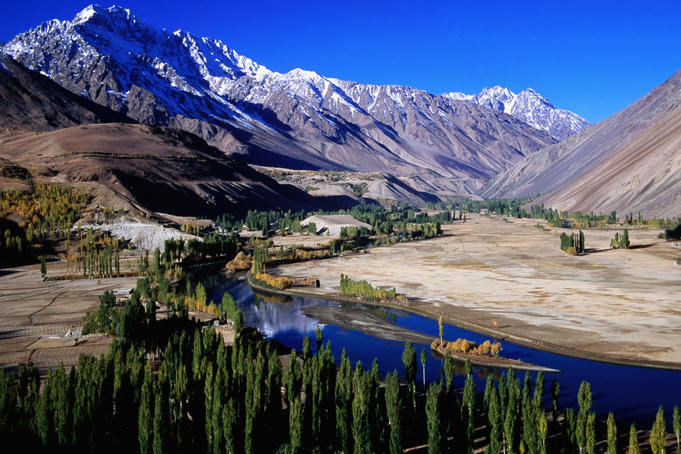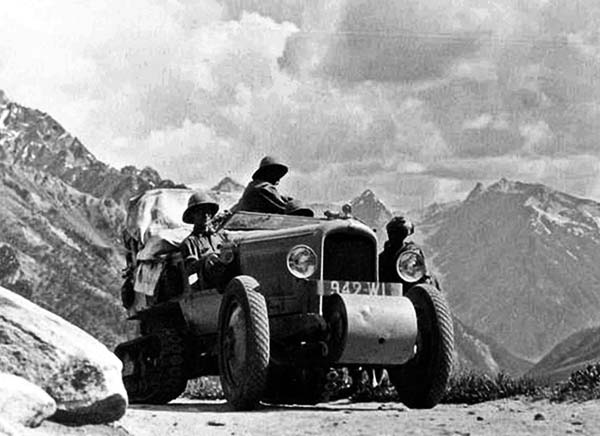Islamabad’s fresh dose of autonomy to the erstwhile Northern Areas have created a lot of heat and dust. R S Gull profiles the region’s history and Islamabad’s efforts to douse the unrest by making more concessions to an area that has been denied a clear constitutional status, and a proper system of governance and justice.

Pakistan’s Northern Areas (72,971 sq km) comprise of Gilgit and Biltistan, now renamed Gilgit-Baltistan by Islamabad’s new constitutional package ‘Gilgit-Baltistan Empowerment and Self Governance Order 2009’. The two regions with almost same agro-climatic situations comprise seven districts Ghezir, Gilgit, Diamar, Astore, Hunza-Nagar (Gilgit), (Skardu) and Ghanche (Baltistan) with as many language and dialects. Many sects exist in the region with Shia Muslims in the majority.
Gilgit, the gateway to Xinjiang Autonomous Region of China and Central Asia, has historically remained an important city on the Silk Road and at the centre of what is being called “the Great Game”. For most of the nineteenth century it was ruled by Raas princes. The Trakhan Dynasty rule (one of Kings was a man-eater) ended in 1810 with the death of Raja Abbas. Baltistan comprised of Skardu and Kargil. The two regions together with Hunza, Nagar and Ladakh became vassals of the princely state of Kashmir and Jammu, but maintained considerable autonomy by 1860. Chitral’s acceptance of Dogra sovereignty completed the process by 1876.
Well before the Dogra tyrant could consolidate his empire, the Empire grew suspicious of the Russian influences in the belt. By 1868, the Empire posted a British officer in Gilgit for intelligence gathering and by 1877, the British government in capacity of the suzerain power of Kashmir established the Gilgit Agency. Comprising Gilgit Wazarat; the state of Hunza and Nagar; the Punial Jagir; the governorships of Yasin, Kuh-Ghizr and Ishkoman, and Chilas, the agency was administered by the British Resident stationed in Srinagar without disturbing the sovereignty of Kashmir autocracy. It actually became functional in 1889.
As the Russian influences supposedly were up (there were schools imparting Russian language trainings in and around Jammu), the British insisted on a 60-years lease of the Gilgit agency and certain surrounding areas. Maharaja was not ready but it eventually happened on March 26, 1935 when he signed the lease deed with British Resident L E Lang. Alternative narratives of the particular era suggest that the rise of Sheikh Abdullah was part of the British pressure to force Maharaja into submission, then the Agency became part of British India, administered by a Political Agent at Gilgit responsible to Delhi, first through the Resident in J&K and later a British Agent in Peshawar. Though the autocracy kept symbolic presence, the Gilgit Scouts (a paramilitary comprising the wards of the seven kings of the belt) were set up in 1913 and paid by Delhi.

(A 1932 photograph taken on the Gilgit Road)
By August 15, 1947, the lease had become untenable and the Empire had ceded the leased areas to Hari Singh’s J&K. Maharaja had appointed Brigadier Ganshara Singh as Gilgit governor who arrived on July 31. By then, however, the situation in the foothills of the Karokaram had changed. By early August reports about Hindu king readying to disband Gilgit Scouts was common knowledge. Gilgit Scouts were led by Scottish officer Major William A Brown. Together with Captain A S Matheison, the two soldiers were supportive of the overwhelming Muslim population that eventually overthrew the Dogra rule. On October 31, the governor was taken into protective custody on Brown’s orders and by November 1, 1947 the Islamic Republic of Gilgit was proclaimed with Raja Shah Rais Khan as its president. Brown survived, returned to England, started a riding school, and died in 1984. His widow received highest state award Sitara-e-Pakistan in 1994 for his contributions in getting Gilgit to Pakistan.
While the Gilgit rebellion spilled over in the arid desert (by January 1, 1949 when LoC separated Ladakh from the Nothern Areas, Scouts had conquered 28000 sq kms in Gilgit, Baltistan, Hunza and Diamir and were apparently keen to create their own sovereignty but were stopped in Ladakh near Zoji La), the Gilgit Republic came to an end on November 16, 1947 with the arrival of the Pakistani Agent, Sardar Mohammad Alam, who took the area into Pakistani possession.
Pakistan lacked any legal instrument to control this belt barring a 1949 decision by the ‘Azad’ Jammu & Kashmir government that it should control the Gilgit-Baltistan-Hunza region.
The region was ruled by a political agent strictly on the colonial pattern. It continued to be termed as ‘Gilgit Agency’. In 1970, when the areas were merged into Northern Areas, the name changed. By 1974, the states of Hunza and Nagar and the independent valleys of Darel-Tangir, which had been de-facto dependencies of Pakistan, were also incorporated into the Northern Areas.
Major development for around two million souls living in most impoverished conditions over the decades has been the construction of 1300-km Karakoram Highway connecting Kashgar (China) with Abbottabad (Pakistan). Construction of the two lane road started in 1966 and concluded in 1986 during which 810 Pakistani and 82 Chinese workers lost their lives. The highest paved international road, being referred to as ‘eighth wonder of the world’, has revived the ancient silk route and runs through “the collision zone” where China, Tajikistan, Afghanistan and Pakistan come within 250 kms of each other. The two countries have signed an MoU on June 30, 2006 to expand its width from 10 to 30 meters so that its transport capacity triples. Besides, it is expected to be linked with the southern port of Gwadar in Balochistan through the Chinese-aided Gwadar-Dalbandin railway, which extends up to Rawalpindi.
The highway could be built only after the two countries signed the boundary agreement of 1963 under which Pakistan ceded 5,180 sq km of territory to China in Shaksgam belt.
The vast belt continued being federally ruled by the Kashmir Affairs and Northern Areas minister without any representation anywhere. For the first time in history, Islamabad in October 1994 permitted political parties of Pakistan when a 26-member council – ‘the Northern Areas Executive Council’, was set up on March 31, 1995. The members had all the perks that their counterparts in other legislative bodies had but lacked the legislative powers. Their role was advisory. In 1999 the apex court recommended extension of legislative, financial and administrative powers besides an independent judiciary with writ jurisdiction which enabled setting up of first Northern Areas Legislative Council in 2000. Legislation on local matters and levying local taxes was permitted.

(A village in Muzaffarbad in PaK.)
For a long time, the Muzaffarabad government has been crying hoarse over the treatment meted out to Northern Areas. Finally they petitioned in the ‘Azad’ J&K High Court which passed a verdict in March 1993 criticizing the unrepresentative and arbitrary administrative system and denial of fundamental rights in the Northern Areas. It directed the Muzafarabad government to take over administrative charge of the region with the support of Islamabad. Pakistan government appealed the verdict before its apex court which on September 14, 1994 upheld the status of Northern Areas as “part of Jammu & Kashmir state” but are not part of “Azad J&K” as defined in the Azad J&K Interim Constitution Act, 1974.
Though Islamabad promulgated Northern Areas Council Legal Framework Order 1974-75 initiating certain administrative, judicial and political reforms and abolishing Jagirdari Nizam and FCR and later the Northern Areas Legal Framework Order, 1994 to ensure more internal autonomy, it is still facing problems. The demands for more rights and better governance are growing louder. The discontent, reflected in riots and violence in 1988, 1993 and 2003. Besides, Islamabad faces the allegations of effecting a demographic change in the mineral rich region.
It was in this background that Pakistan announced Gilgit-Baltistan (Empowerment and Self-Governance) Order 2009 last month. Apart from renaming the region as Gilgit-Baltistan (GB), the order envisages a slew of new measures. Now the GB will have a governor and its legislative assembly (24 elected members plus three nominated women and three technocrats) will elect a chief minister and six minister council plus two advisors. While the assembly can legislate on 61 issues, the 15-member council (six members recommended by the president, prime minister of Pakistan and the governor of GB and six nominated by the chief minister and legislative assembly of the region) will have legislative rights over 55 subjects. The twin bodies are empowered on financial matters and can pass the budget. The GB will get Chief Judge of Supreme Appellate Court on the pattern of ‘Azad’ J&K besides and an Auditor General and a Chief Election Commissioner. The blueprint envisaging ‘self rule’ falls short of declaring GB as another province of Pakistan.
The step by the government is a good omen towards granting the fundamental rights to the people of the mountainous area since the last six decades they have been deprived of their constitutional, political, financial and democratic rights. They have been demanding a system akin to that of Muzaffarabad government if the impending Kashmir issue prevented Islamabad from granting the region complete provincial autonomy like other federating units with full-fledged provincial assembly and governor, along with their representation in Senate and National Assembly of Pakistan.
So the reaction to the package remained mixed. Many on either side of the Radcliffe divide said it was expected to weaken the Kashmir case, a concern rejected by Islamabad. The unhappy nationalists in GB termed it as the ‘Ordinance for Advancement of Slavery’ insisting that Pakistan lacks any legal or moral authority to go for such an order. They see a ‘governor’s rule’ in Order’s ‘self rule’.
Instead they are demanding freedom of speech, complete political rights including total governance, end of the involvement of security agencies in local affairs, upholding state subject law, demilitarization and finally restoration of routes between Kargil and Skardu, Chorbat and Nubra, Gultari and Drass, Guraiz and Astore, Ishkomen and Tajikistan.

(Chinese working on the Karokaran Highway in Gilgit Baltisatan)
Gilgit-Baltistan is the only region in undivided Jammu and Kashmir where state subject law has been abrogated by Pakistan, causing much resentment among the locals.
Whether or not the move is linked with the Kashmir, there are experts suggesting that devolution of more autonomy to the neglected region is aimed at guarding Beijing’s interests. Apart from the investments already made in the region, China is investing US $ 7 billion in proposed Bunji dam to generate 7,000 MWs of clean energy on BOOT basis. MoU for this project was signed during President Zardari’s China visit in August.
The two countries also agreed in June to allow market access for bilateral trade in 11 services sectors and to intensify their efforts to increase border trade, which constitutes merely 5% of their overall trade, and takes place through the Karakoram Highway (KKH), whose repair and upgrade is likely to be completed by 2012. Other projects that China is setting up in the region include construction, maintenance and expansion of the KKH, small hydro-power projects, construction of a dry port at Sost on Sino-Pakistan border (connected by the KKH to Karimabad, Gilgit and Chilas on the south and the Chinese cities of Tashkurgan, Upal and Kashgar in the north), water-diversion channels, bridges, railway projects and telecommunication facilities.
Besides, Islamabad is also poised to undertake the construction of the $12.6 billion Diamer-Bhasha dam on Indus 40km downstream of Chilas, with a capacity to generate 4,500 MW. Work on the dam has begun and is expected to be over by 2016.















